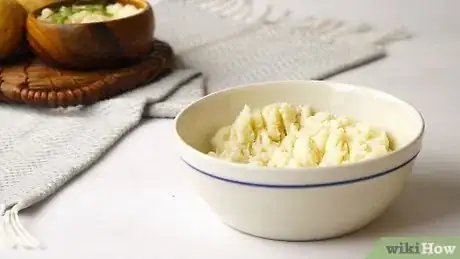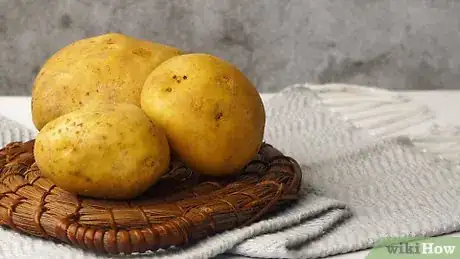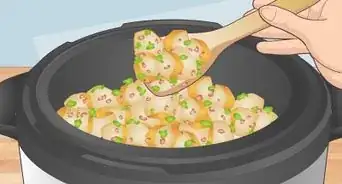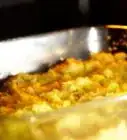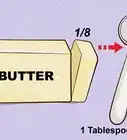This article was co-authored by Ollie George Cigliano. Ollie George Cigliano is a Private Chef, Food Educator, and Owner of Ollie George Cooks, based in Long Beach, California. With over 20 years of experience, she specializes in utilizing fresh, fun ingredients and mixing traditional and innovative cooking techniques. Ollie George holds a BA in Comparative Literature from The University of California, Berkeley, and a Nutrition and Healthy Living Certificate from eCornell University.
There are 8 references cited in this article, which can be found at the bottom of the page.
wikiHow marks an article as reader-approved once it receives enough positive feedback. In this case, several readers have written to tell us that this article was helpful to them, earning it our reader-approved status.
This article has been viewed 479,757 times.
Mashed potatoes are a side dish that can be eaten immediately after being cooked or eaten as leftovers the next day. Mashed potatoes can also be cooked earlier in the day for serving later. No matter when you intend on eating the mashed potatoes, they're best enjoyed when served hot. The following are the steps in how to reheat mashed potatoes.
Steps
Reheating Refrigerated or Frozen Potatoes
-
1Thaw your mashed potatoes. To serve reheated potatoes that are as moist as a freshly cooked dish, allow your potatoes to thaw first if you've frozen them. This way you can stir in additional cream more easily. If you reheat frozen potatoes straight from the freezer, allow extra cooking time in the beginning until they've warmed and softened enough to stir the cream in effectively.
-
2Use a pan on your stovetop. First, pour some cream. Bring it to a simmer. Stir your mashed potatoes into the cream evenly. Continue to stir until the potatoes are heated through. If needed, add more cream and wait for it to come to a simmer, then stir it into the potatoes.[1]
- Depending on the amount of potatoes you’re reheating and the size of the pan, it’s best to start off with too little cream than too much. At the very least, use enough to coat the bottom of the pan.
- Use a food thermometer to check the potatoes’ internal temperature; for health reasons, the potatoes should reach at least 165º before they’re safe to eat.[2]
Advertisement -
3Reheat the potatoes in a skillet. Grease your skillet with cooking oil. Set the burner to medium heat. Once your skillet’s hot, scoop your potatoes in. Flatten them into a pancake so they cook quicker. Stir them up frequently and flatten them again until they’ve heated through.
- The cooking oil should add some moisture to your potatoes. However, if they're still drying out, mix in some cream to rehydrate them.
- Use a food thermometer to check the potatoes’ internal temperature; for health reasons, the potatoes should reach at least 165º before they’re safe to eat.[3]
-
4Stick the potatoes in the oven. Preheat the oven to 350º. Transfer your potatoes to an oven-safe dish. Stir the potatoes with a small amount of cream to rehydrate them. Cover them with either the dish’s lid or aluminum foil. Once the oven’s reached the desired temperature, place the dish inside. Cook for roughly 30 minutes.[4] Depending on the amount of potatoes you’re reheating, check them every 5 minutes starting at the 15-minute mark to see if they’ve already heated through. Stir in more cream if the potatoes are drying out too much.[5]
- Use a food thermometer to check the potatoes’ internal temperature; for health reasons, the potatoes should reach at least 165º before they’re safe to eat.[6]
- Unfortunately, your potatoes are bound to lose moisture as you reheat them. Adding in some cream, butter, or sour cream can help compensate for this.[7]
-
5Nuke the potatoes. Transfer your potatoes to a covered, microwave-safe dish. Stir in a small amount of cream to rehydrate them. Cook them in your microwave at half-power for a couple minutes. Uncover the dish, stir your potatoes, and sample to judge the heat. Repeat as needed until your potatoes reach your desired temperature.[8] [9]
Keeping Potatoes Warm After Cooking
-
1Break out your slow cooker. Grease the inside with butter. Pour enough cream or milk to line the bottom. Scoop your potatoes in, stir, and set the cooker to LOW. Serve your potatoes at any time up to 4 hours after doing so. Continue to stir at least once an hour in the meantime.[12]
-
2Make an impromptu double-boiler. Transfer your potatoes to a bowl. Cover the bowl with aluminum foil, plastic wrap, or a clean dish towel. Break out a pan large enough to fit the bowl. Fill the pan with a fair amount of water to boil (if the pan is deeper than the bowl, be careful not to fill it with too much water; you don’t want to submerge the bowl). Bring the water to a boil, then lower the heat to simmer. Place the bowl into the water. Stir your potatoes every 15 minutes until your meal is ready to serve. Add more boiling water to the pan if the original water begins to evaporate.[13]
-
3Turn a cooler into a heater. If you don’t have a burner to spare on your oven, grab an ice cooler. Instead of ice, boil some water and fill the bottom.[14] Cover your bowl of potatoes with aluminum foil, plastic wrap, or a dishcloth. Set your bowl inside the cooler and seal the lid. Stir your potatoes every 15 minutes until your meal is ready to serve. If the water inside the cooler cools off, drain the cooler and add more boiling water to keep your potatoes warm.
- If your cooler is too small to fit your bowl of potatoes, scoop them into heavy-duty, sealable storage bags and set those inside your cooler.[15]
Prepping Your Potatoes for the Freezer or Fridge
-
1Use the right ingredients. If possible, avoid starchy potatoes, like russets, since starch will effect your mashed potatoes’ texture when frozen.[16] Use a waxy or all-purpose potato, like Red Bliss (waxy) or Yukon Gold (all-purpose), which have move moisture.[17] Add plenty of cream, butter, and/or cream cheese to your recipe to keep your potatoes moist.[18] [19]
-
2Portion your potatoes before freezing. Line a baking sheet with parchment paper. Dole your mashed potatoes out into single servings with an ice cream scooper or measuring cup. Freeze the tray until the potatoes harden completely. Switch them to a storage bag or other container. Then place them back into the freezer and help yourself to a serving at a time.[20]
-
3Flatten your potatoes. If storage space in your freezer is an issue, transfer your warm mashed potatoes into small storage bags. If you’re going to reheat them periodically instead of all at once, choose a size that will hold the number of servings you expect to reheat at one time. Fill them and then flatten the potatoes with the bag open so air can escape. Then seal each bag and freeze as many as space permits. Once they’re frozen hard, stack or otherwise arrange them in your freezer to optimize space.[21]
Expert Q&A
-
QuestionHow do you revive leftover mashed potatoes?
 Ollie George CiglianoOllie George Cigliano is a Private Chef, Food Educator, and Owner of Ollie George Cooks, based in Long Beach, California. With over 20 years of experience, she specializes in utilizing fresh, fun ingredients and mixing traditional and innovative cooking techniques. Ollie George holds a BA in Comparative Literature from The University of California, Berkeley, and a Nutrition and Healthy Living Certificate from eCornell University.
Ollie George CiglianoOllie George Cigliano is a Private Chef, Food Educator, and Owner of Ollie George Cooks, based in Long Beach, California. With over 20 years of experience, she specializes in utilizing fresh, fun ingredients and mixing traditional and innovative cooking techniques. Ollie George holds a BA in Comparative Literature from The University of California, Berkeley, and a Nutrition and Healthy Living Certificate from eCornell University.
Private Chef & Food Educator The best way to reheat mashed potatoes is to transfer them to a baking dish and spread them to a single, even layer. This will the minimize the drying out and allow them to warm faster.
The best way to reheat mashed potatoes is to transfer them to a baking dish and spread them to a single, even layer. This will the minimize the drying out and allow them to warm faster. -
QuestionHow long can I keep mashed potatoes in the refrigerator and can they be safe to eat?
 Community AnswerAs long as they're covered, mashed potatoes can keep for two or three days in refrigeration.
Community AnswerAs long as they're covered, mashed potatoes can keep for two or three days in refrigeration. -
QuestionCan I store mashed potatoes in an aluminum tray overnight and reheat them the next day in it?
 Community AnswerAs long as you do not add any acid to the potatoes (vinegar, lemon juice, tomato sauce, etc.), you should be fine. Acidic foods dissolve the aluminium
Community AnswerAs long as you do not add any acid to the potatoes (vinegar, lemon juice, tomato sauce, etc.), you should be fine. Acidic foods dissolve the aluminium
Warnings
- Times and temperatures for reheating will vary depending on your equipment and the amount of potatoes that you’re reheating. Check and sample your potatoes frequently as you reheat them the first time to gain a better idea of how long they need to cook and at what temperature.⧼thumbs_response⧽
- Slow cookers are not recommended for reheating potatoes that have been frozen or refrigerated.[23]⧼thumbs_response⧽
References
- ↑ http://www.seriouseats.com/2014/11/3-ways-to-make-mashed-potatoes-in-advance-thanksgiving-easy.html
- ↑ http://www.fsis.usda.gov/wps/portal/fsis/topics/food-safety-education/get-answers/food-safety-fact-sheets/safe-food-handling/leftovers-and-food-safety/ct_index
- ↑ http://www.fsis.usda.gov/wps/portal/fsis/topics/food-safety-education/get-answers/food-safety-fact-sheets/safe-food-handling/leftovers-and-food-safety/ct_index
- ↑ Ollie George Cigliano. Private Chef & Food Educator. Expert Interview. 18 October 2021.
- ↑ http://www.thekitchn.com/the-best-way-to-freeze-and-reheat-mashed-potatoes-225440
- ↑ http://www.fsis.usda.gov/wps/portal/fsis/topics/food-safety-education/get-answers/food-safety-fact-sheets/safe-food-handling/leftovers-and-food-safety/ct_index
- ↑ Ollie George Cigliano. Private Chef & Food Educator. Expert Interview. 18 October 2021.
- ↑ http://www.thekitchn.com/the-best-way-to-freeze-and-reheat-mashed-potatoes-225440
- ↑ Ollie George Cigliano. Private Chef & Food Educator. Expert Interview. 18 October 2021.
- ↑ http://www.fsis.usda.gov/wps/portal/fsis/topics/food-safety-education/get-answers/food-safety-fact-sheets/safe-food-handling/leftovers-and-food-safety/ct_index
- ↑ Ollie George Cigliano. Private Chef & Food Educator. Expert Interview. 18 October 2021.
- ↑ http://www.thekitchn.com/how-to-keep-mashed-potatoes-warm-cooking-lessons-from-the-kitchen-69010
- ↑ http://www.thekitchn.com/how-to-keep-mashed-potatoes-warm-cooking-lessons-from-the-kitchen-69010
- ↑ http://www.seriouseats.com/2014/11/3-ways-to-make-mashed-potatoes-in-advance-thanksgiving-easy.html
- ↑ http://www.seriouseats.com/2014/11/3-ways-to-make-mashed-potatoes-in-advance-thanksgiving-easy.html
- ↑ http://www.theyummylife.com/how_to_freeze_mashed_potatoes
- ↑ http://www.huffingtonpost.com/2014/02/28/potato-varieties_n_1105586.html
- ↑ http://www.thekitchn.com/the-best-way-to-freeze-and-reheat-mashed-potatoes-225440
- ↑ http://www.favoritefreezerfoods.com/make-ahead-mashed-potatoes.html
- ↑ http://www.theyummylife.com/how_to_freeze_mashed_potatoes
- ↑ http://www.theyummylife.com/how_to_freeze_mashed_potatoes
- ↑ http://www.thekitchn.com/the-best-way-to-freeze-and-reheat-mashed-potatoes-225440
- ↑ http://www.thekitchn.com/how-to-keep-mashed-potatoes-warm-cooking-lessons-from-the-kitchen-69010
About This Article
To reheat mashed potatoes, stir in some cream to rehydrate them, and microwave them at half power for a few minutes. Check to see if they’re warm, and microwave them for a few more minutes if necessary. Alternatively, bring some cream to a simmer in a pan on the stove, then stir in your potatoes. Continue stirring until your potatoes are heated through, adding more simmered cream if you need to. You can also reheat your potatoes by stirring in some cream and putting them in a 350°F oven for 30 minutes. To learn how to keep your mashed potatoes warm after you’ve cooked them, scroll down!
